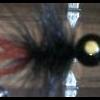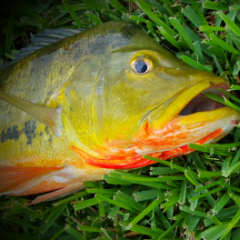I wrote a horizontal jigging artical for In-Fisherman magazine over 17 years ago, Jan 1995. This presentation was considered old back then!
horizontal jigging is another term for casting a jig and retrieving back along the bottom structure and works best in deep structured lakes during seasonal periods where bass and prey are migrating; pre spawn and fall transition.
The presentation relies on a jig designed to achieve a hook set when the line angle is less than a 45 degree angle down in the water, when the jig is more verticle or more than a 45 degree angle like straight down or 90 degrees you are fishing vertical and close to the bass; pitching and flipping presentations.
My average cast is about 90 feet or 30 yards out to 120 feet or 40 yards, rarely longer.
I designed a modified football head that more resembles a viper snake head shape and use 5/0 Gamakatsu #114 forged hook; very strong and extremely shape, the hook point about ***/4" behind the jig head, this is a critical factor to achieve hook set sets. I don't use a traditional weed guard, I use a CPS or Hitchhiker spring and attached a ***/4 to 2" split tail section of finesse worm and insert the jig hook point into the crouch of the razor cut split in the worm tail to cover the hook point to help prevent snagging when fishing light cover or brush. A standard football head will work, but tend to hang up more often in broken rock. There is a new jig coming out called a Nu Jig that has a unique double weed guard and head shape that works very well without adding the finesse worm to cover the hook point and slides through rocky structure very well.
The key to my success is the tackle and how I hold the rod, the line and position the rod during the retrieve.
The rods should be at least 6'6" fast action 4 to 5 power light weight sensitive jig/worm rod. My rods are custom 4 and 5 power, 6'10" Hydra rods made by ALX, very similar to Loomis NRX rods, any good rod will do.
Any good quality casting reel like Ardent 1100, the older Shimano Curado and Lewis 's pro series reels are all good, in 6.3 to 1 ratio. Line is another personal choice; I like Sunline Shooter 14 lb, it's pricey and also use P-Line FluroClear 12 lb, about the same diameter and good performance at 1/4 the price.
My jig is a custom 7/16 oz, a good quality 1/2 oz football head like Cody's Phenix jig or the Nu jig would be good. I tie my own custom buck tail hair jigs in 3 color combinations; black back, purple middle and rust brown belly and call this anytime anywhere. The second is rust brown back, green center and brown belly and call,this spring craw. Trilers are pork died 1 of the colors in the jig: usually rust brown or purple. At night or low light the trailer is usually black or purple.
I make a long cast and let the jig fall on a controlled slack line while watching the V the line makes in the water. When the jig hits bottom you will see the line jump, see and feel the jig hit bottom. I hold the rod in front of the reel, with the line over my index finger, the rod pointed at the jig, rod tip near to parallel with the water surface. The retrieve is very simple, I just turn the reel handle 1 to 3 turns depending on the bottom slope contour; I want the jig to jump forward about 6" to 12", and let it come to a stop then without raising the rod tip, I watch and feel the line for any indication of a strike; the line moving to one side, a thump, a bump, a tick or nothing no feed back like the jig was cut off. My reaction to any of the above is quickly to turn the reel handle serveral turns to tighten up the line and if I believe a bass has the jig, then I keep reeling until the line is tight and sweep the rod back hard.
If it's not strike, just lower the rod back down and continue the retrieve. if you encounter a obstickle like rocks or wood limb, then gently raise the rod tip to lift the jig over the obstickle and continue the stop and go retrieve: turn the reel handle, let the jig fall and stop and repeat the retrieve . This sounds simple and it is, but you must concentrate on every cast, the bass that eat a jig cast a long distance don't know you are there and they often big bass.
You can substitute soft plastic for,the pork trailers and appeal to a wider range of bass sizes, pork seems to appeal to bigger bass.
The depth I fish depends on the thermocline, but rarely deeper than 35', usually between 3' to 25' .
Good luck.
Tom



.thumb.jpg.df52404fc648bc17a641a50eb4c9dac9.jpg)
